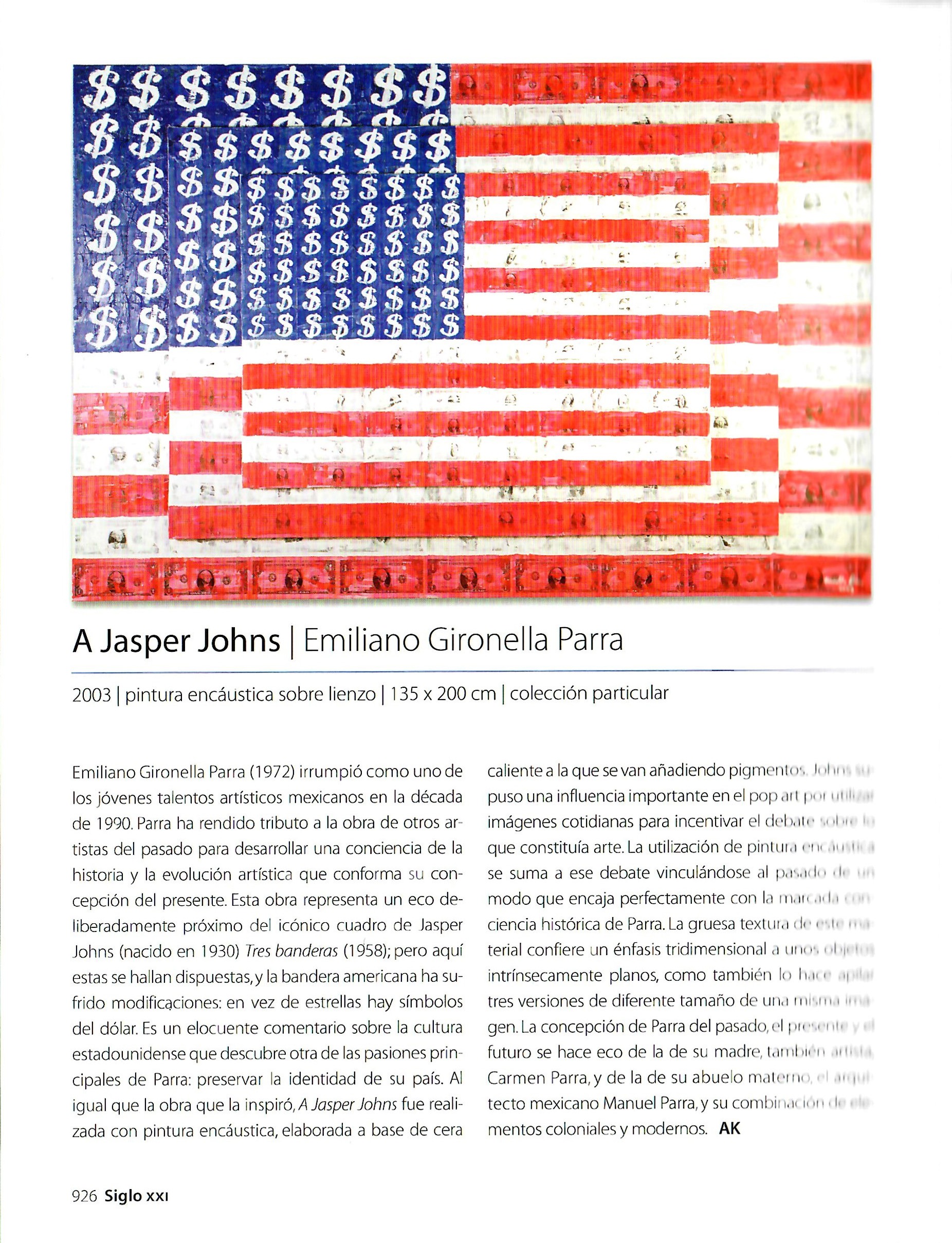Publications
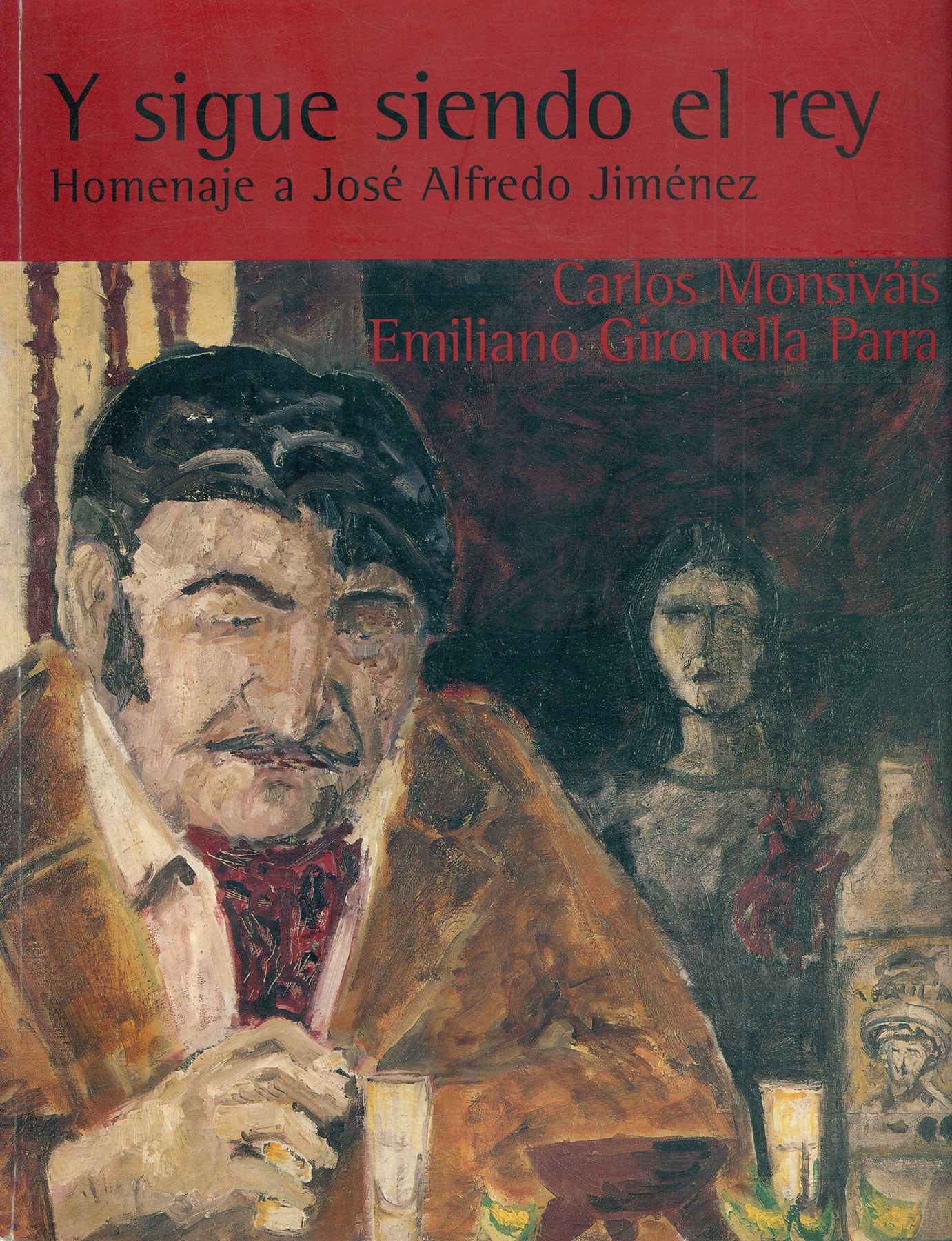
Y sigue siendo el rey
Emiliano Gironella Parra
Fundación Cultural Artención
Mexico City
Y sigue siendo el rey
“José Alfredo Jiménez: ‘I will tell you that I came from a strange world’” is the title of the essay by Carlos Monsiváis included in the exhibition catalog Y sigue siendo el rey by Emiliano Gironella. In it, Monsiváis considers José Alfredo an institution of institutions that does not go out of style, whose songs are still alive, loaded with new and unexpected meanings: “Gradually, the hidden or minimized dimension of José Alfredo’s work is the most favored, and the spokesman for bartending lyrics becomes the poet of marginal desolation”. Poet because some lines of his songs “work [for the listener] like poetry, they illuminate beings, situations and personal sequences”. José Alfredo’s poetry is popular because his meaningful phrases help us feel ok with ourselves, a range of illuminations that, for lack of another name, amount to a philosophy of life.
In a series of oil paintings marked by a love of myth and the search for visible correspondence with a world both closed and open, Gironella confirms the growing and irreversible cultural and artistic recognition of José Alfredo. “In his devotion to symbols and allegories, Emiliano Gironella delivers a version of José Alfredo that illuminates the perennial relevance of a composer and a repertoire”.
Y sigue siendo el rey, a tribute to José Alfredo Jiménez, was exhibited at the National Museum of Popular Cultures in 1998, Mexico City. It consists of 19 works, most of them oil paintings on different materials: linen, cardboard, wood and fabric. Also part of the exhibition are some woodcuts, a sheepskin (woodcut and oil on wood) and a cross (bottles, silver leaf on wood).
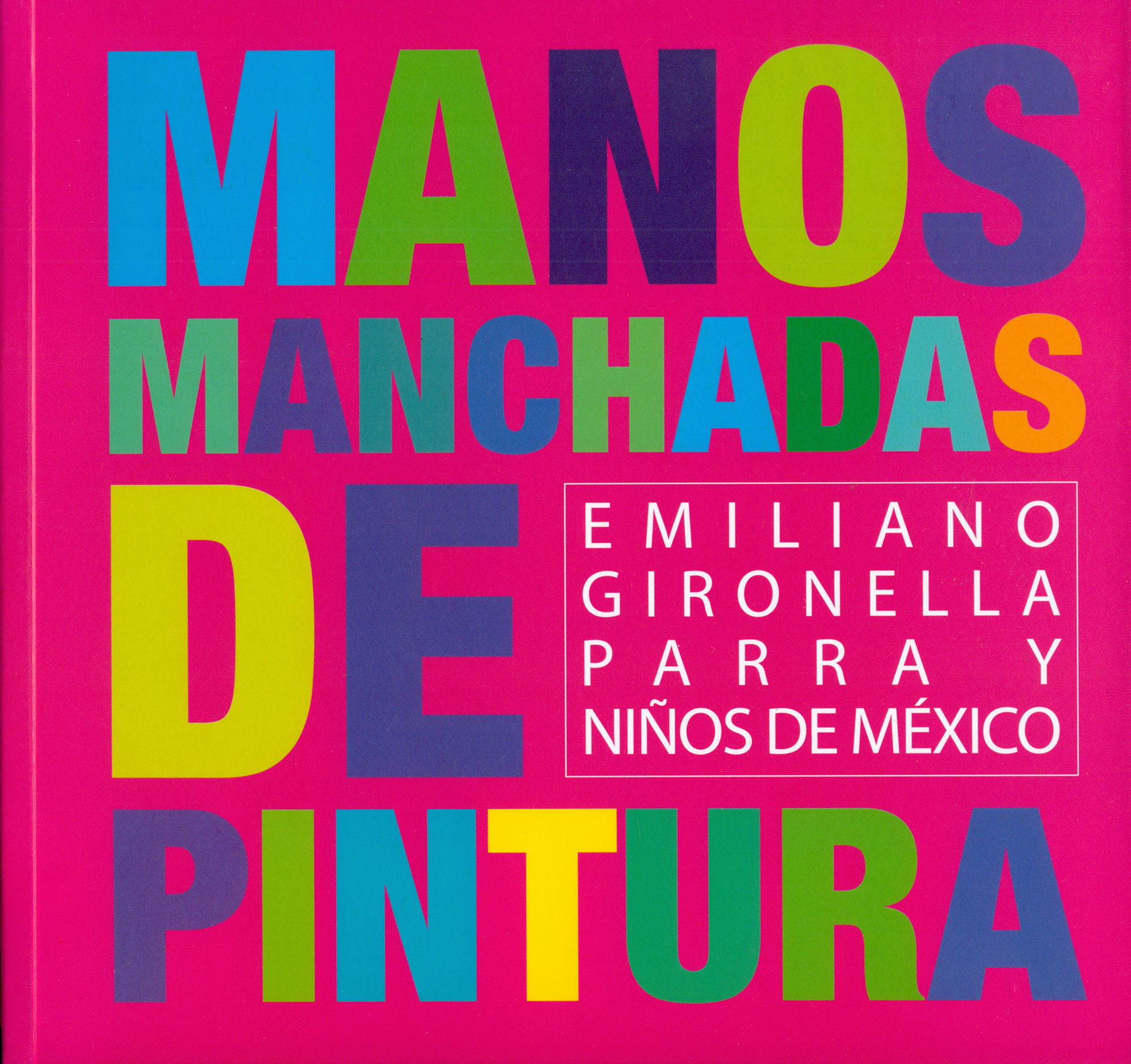
Manos manchadas de pintura
Emiliano Gironella Parra
El Aire Centro de Arte A.C.
Mexico City
Manos manchadas de pintura
The works presented in the book Manos manchadas de pintura are the result of three art workshops taught by Emiliano Gironella Parra in July 2011 in his studio. 36 boys and girls between the ages of 4 and 14 participated in these workshops, all of them children of Mexican federal police officers who died in the fight against crime. Through an artistic process that included reading stories about the exploits of heroes against villains, Emiliano helped these children understand the value of their parents´ sacrifice. The artistic process helped them mitigate their pain by arousing their admiration and encouraging them to create with their hands. Gironella Parra’s artistic action consisted mainly of enlivening the children’s natural creative impulses, directing them physically and lending visual coherence and finish to the works they spontaneously created.
The book features three texts that speak to the importance of Emiliano’s workshops. Each author reports from a different angle, according to their professional experience and the objective of their work. These include: a prologue by Dr. Manuel Mondragón y Kalb, National Security Commissioner; a preface by Josefina Ricaño de Nava, president of México Unidos Contra la Delincuencia, A.C. , and an essay by Pablo J. Rico, director of museums and foundations, exhibition curator, editor, writer, professor and lecturer.

Artempatía
Emiliano Gironella
Pablo Rico
Consejo Nacional para la Cultura y las Artes
Mexico City
Artempatía / Empathy Art
In his text “The therapy of art”, which introduces the reading of Artempatía / Empathy Art, Rafael de Tovar y de Teresa expresses the firm conviction that “education and culture are solid tools in the fight against violence […] they help recompose the social fabric because they can forge awakened and enlightened consciences”. He celebrates the appearance of this book because it traces the way in which outstanding artists – in an arc that stretches from the Spanish painter Francisco de Goya to the Serbian artist Marina Abramovic – have treated the theme of violence and war. “These artists […] are the direct and indirect antecedents of the project of a young Mexican who understands that art is useful and civilizing.” By opening the doors of his workshop to children affected by violence, “Gironella has understood that art also puts itself in the place of others: it is pure empathy.”
Divided into two parts and profusely illustrated, Artempatía / Empathy Art opens with three texts by Pablo J. Rico that analyze art and violence throughout history, empathy and compassion through art, and ethical commitments against violence in contemporary art. The second part, dedicated to the artistic work of Emiliano Gironella Parra, includes three essays, also by Pablo J. Rico: one that speaks of Emiliano’s cycles and series on violence, another examines his art-therapy workshops and a third addresses previous considerations to develop an artistic-pedagogical project against violence. The book closes with an interview of Emiliano conducted by Dr. Silvia Montes, and two texts that address his last two projects: “Heroes” and “Cicatrices.”
Illustrated books
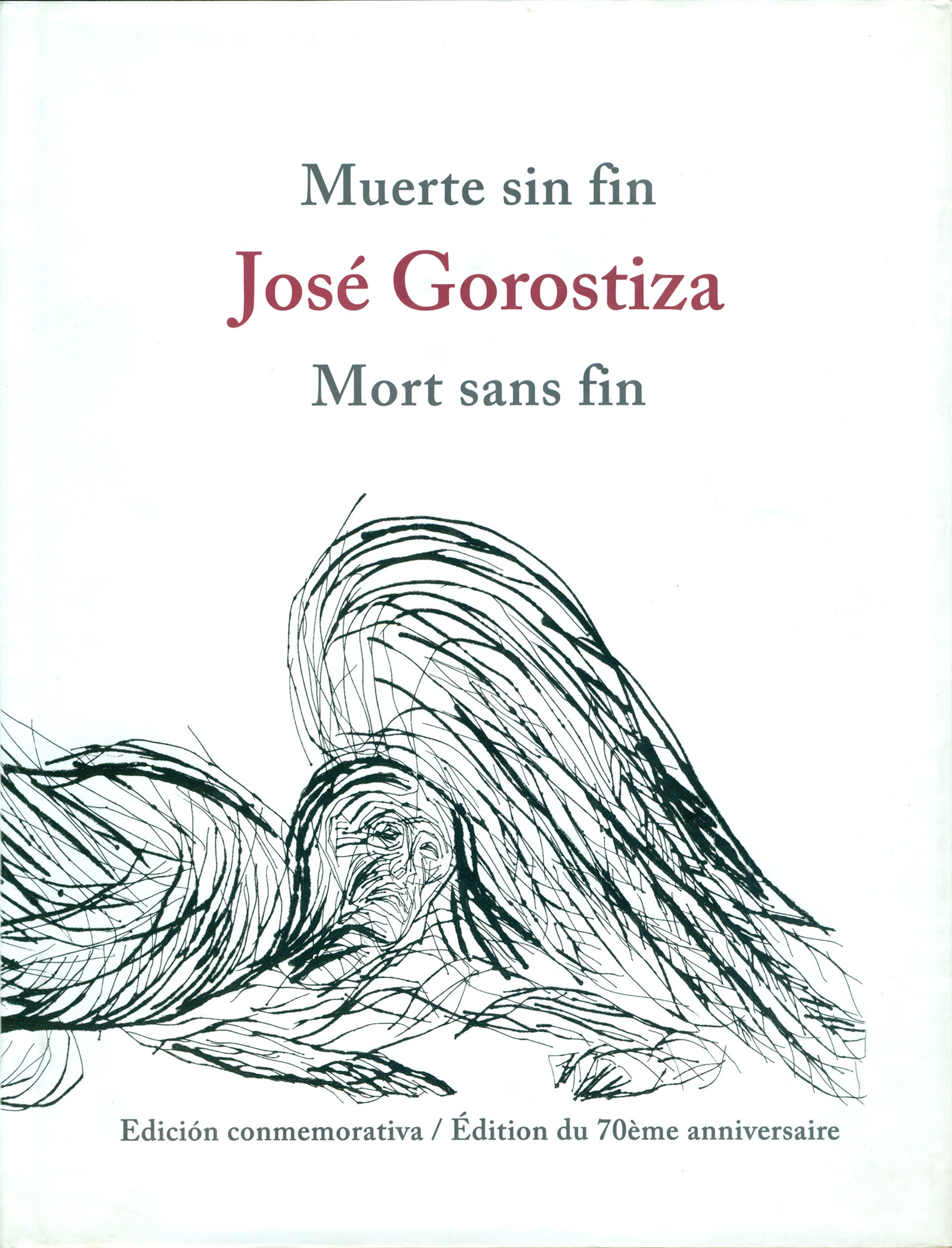
Muerte sin fin / Mort sans fin
Emiliano Gironella Parra
translation of texts to the edition, Sergio Ugalde Quintana.
Consejo Nacional para la Cultura y las Artes: J. Pablos
Mexico City
Muerte sin fin / Mort sans fin
Mexico al filo, an exhibition by Emiliano Gironella Parra dedicated to drug trafficking
José Gorostiza’s poem Muerte sin fin was first published in 1939. Seventy years later, in 2009, Conaculta celebrates this anniversary with an edition in Spanish and French, which is a double homage: to the poem and to Spanish-speaking readers, as they will have access to the French translation by Claude Couffon, published in 1991 by La Différence publishing house, with a preface by Mexican writer Vilma Fuentes to introduce the French public to the poetic work of José Gorostiza.
Muerte sin fin /Mort sans fin offers the most refined version of Gorostiza’s poem, free of the errata of the publications subsequent to its princely edition, presented by Arturo Cantú in his edition and study En la red de cristal (2005). Also included in the first part, corresponding to the Spanish edition, is the aforementioned study by Cantú, dedicated to the analysis of the meaning of the poem, where the original structure that sustains the work is vindicated.
Of Muerte sin fin, José Gorostiza’s masterpiece, one of the greatest poems of Mexican literature, it can also be said that it is “one of the summits of Spanish poetry of all times and a high point of modern universal poetry, in the tradition of the extended poem that culminates under great names such as those of T. S. Eliot and Paul Valéry”, says Sergio Vela in his presentation. Gorostiza’s poem in Spanish is accompanied by the graphics of Emiliano Gironella Parra, who, captivated by Muerte sin fin, created a sort of Gorostiza Suite, composed of 12 drypoint engravings.
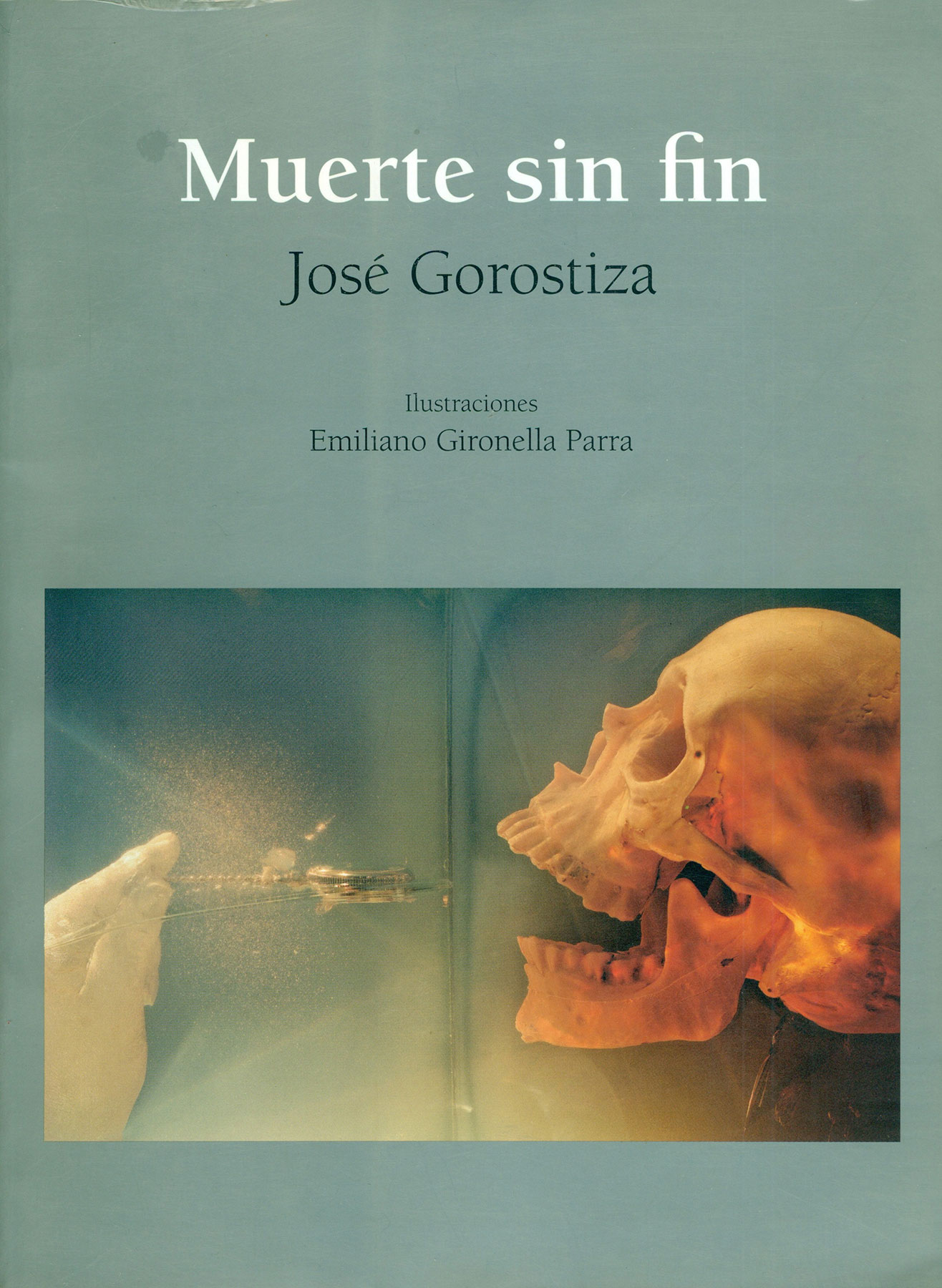
Muerte sin fin
José Gorostiza
Illustrated by Emiliano Gironella Parra
El Colegio de México
Tabasco state government
Mexico Ciy
Muerte sin fin
For José María Espinosa, in charge of presenting this book, Muerte sin fin by José Gorostiza is one of the three greatest poems in Mexican literature, along with First Dream by Sor Juana Inés de la Cruz, and Sun Stone by Octavio Paz.
The poem was initially published in 1939 and has seen various editions since then. This 2009 edition offers the most refined version of Muerte sin fin, which Arturo Cantú includes in his analytic volume “En la red de cristal, Edición y estudio de Muerte sin fin de José Gorostiza” (2005). Here the poem is freed from the errata of other editions subsequent to the first, while Cantú manages to vindicate the original structure that sustains the work.
Seventy years later, this commemorative edition is a tribute to José Gorostiza and at the same time a celebration of Mexican letters and poetry.
Accompanying the work of José Gorostiza are the graphics of Emiliano Gironella Parra who, captivated by Muerte sin fin, created a sort of Gorostiza Suite made up of 9 drypoint engravings. The edition also includes reproductions of a selection of sculptural work (sculptural casts in methacrylate) and pictorial work (oil, mixed media and watercolor) — 16 in total — made by Gironella Parra over four years.
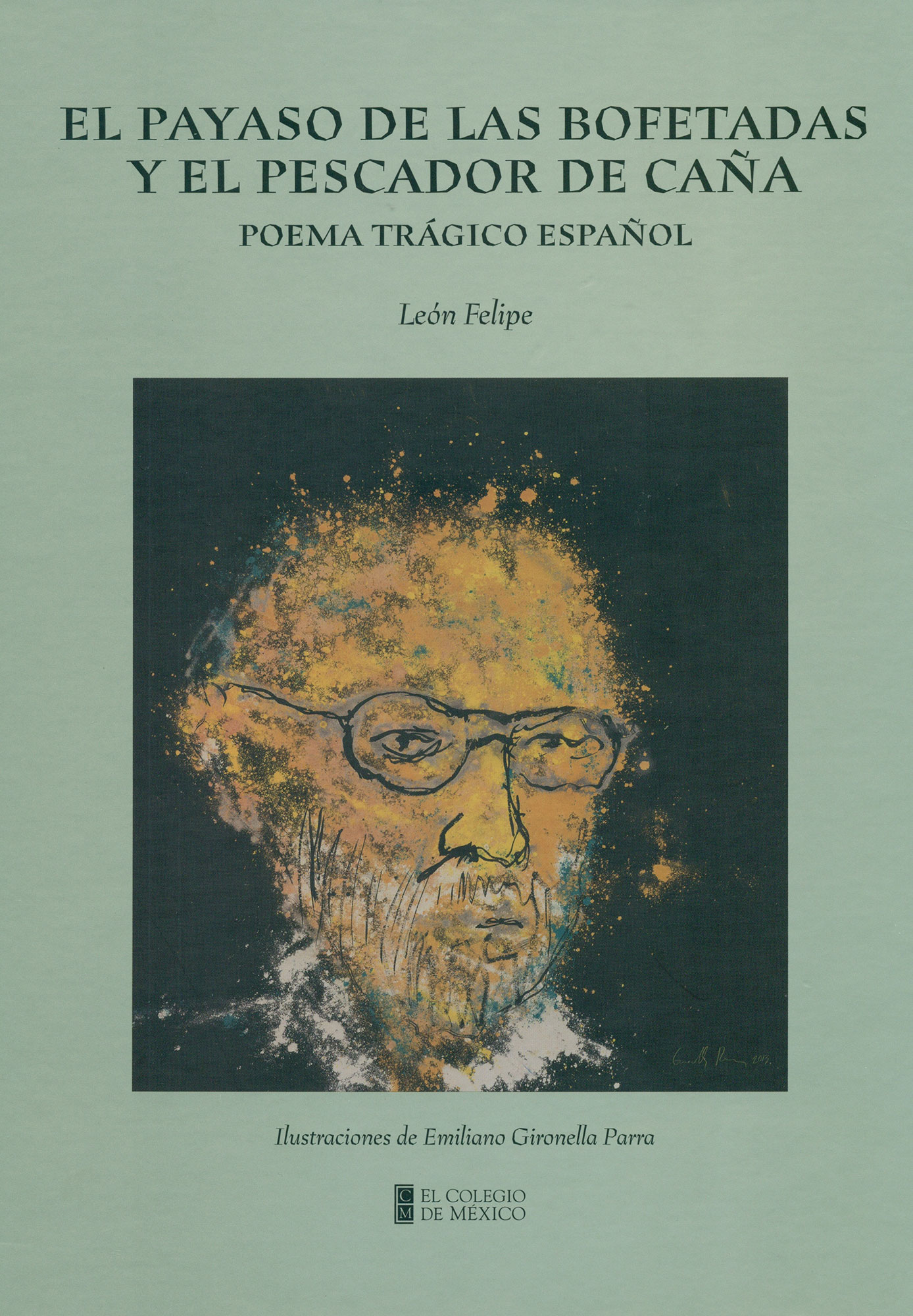
El payaso de las bofetadas y el pescador de caña
León Felipe
Illustrated by Emiliano Gironella Parra
El Colegio de México
Mexico City
El payaso de las bofetadas y el pescador de caña
El payaso de las bofetadas y el pescador de caña, in the words of León Felipe, “is a poem born of old blood; of the eternal and recent blood of Spain”, Written in 1938 during the Spanish Civil War, it is a poem whose verses reflect the drama of the poet´s homeland: the triumph of illegality, injustice and oppression. The central character of the poem is Don Quixote, a Promethean poet who possesses that essential human ability to suggest the transition from a mean world to a noble one. In this work, León Felipe intends to show how a poet like the Caballero de la Triste Figura, who writes “not with the tip of the pen, but with the tip of the lance,” takes a poetic metaphor and merges it with the greater social metaphor.
Emiliano Gironella Parra appropriates some of the ideas expressed by the Spanish poet and forcefully expresses them in 13 monotypes unified by scarlet red, the color of blood, and 12 dry point engravings.
To commemorate the 75th anniversary of the founding of La Casa de España in Mexico, its successor, El Colegio de México, reissues the first book published by that institution in 1938: El payaso de las bofetadas y el pescador de caña by León Felipe, in a new edition beautifully illustrated by Emiliano Gironella Parra.
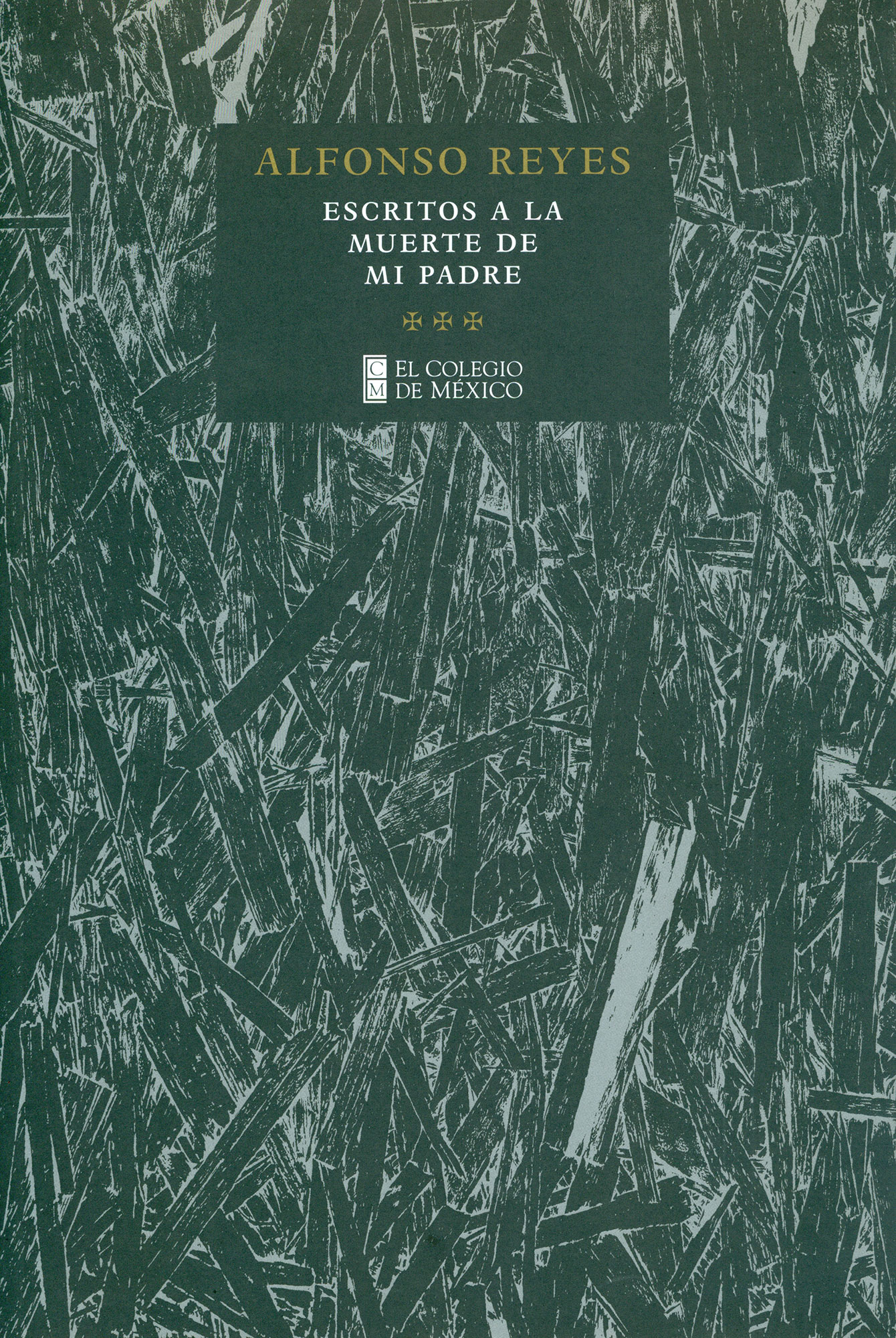
Escritos a la muerte de mi padre
Alfonso Reyes
Illustrated by Emiliano Gironella Parra
El Colegio de México
Mexico City
Escritos a la muerte de mi padre
Escritos a la muerte de mi padre brings together the main texts of Alfonso Reyes on the death of his father, General Bernardo Reyes, an influential Porfirista who died at the beginning of the February 1913 barracks against President Madero.
In the counter-current cultural movement that began in the fifteenth century, the Spanish poet Jorge Manrique published his famous Coplas for the death of his father. With this work he distanced himself from the current canon of the time, “courtly love”. Far from dedicating his work to a beloved or idealized woman, he performs a funerary elegy for the father figure: a recognized noble and military man belonging to the Order of Santiago, extolling the lineage and nobility of the warrior.
Escritos a la muerte de mi padre is prayer and evocation; the sorrow of the loss and the spirit of revenge are diluted in a certain romanticization of the father: an idealization that makes him hero of a thousand battles, a powerful righteous man.
Emiliano Gironella´s illustrations (woodcuts with application of gold leaf) accompany this edition commemorating the 125th anniversary of the birth of Alfonso Reyes. The artist reinforces, line by line, thanks to a saturation of visually oppressive lines, the feeling of those “ominous days”, almost unbreathable, “the violent explosion of shrapnel in life”.

La Tierra Baldía
T. S. Eliot
Illustrated by Emiliano Gironella Parra
El Tucán de Virginia
Mexico City
The Waste Land / La tierra baldía
In T. S. Eliot’s The Waste Land, the dead sprout and bear fruit, as the polyphonic echo of human desolation caused by the barbarism of the Great War. One breathes in the solitude that flows from the poem, even during sex or in a crowd, as in a landscape by Baudelaire, with whom certain “correspondences” are woven; poetic relations by which senses and sensations overlap.
Just as in Eliot’s poem, the voices of great poets of the past resonate in this beautiful and ambitious edition, one of the most notable published in Spanish for its intentions, format (two volumes) and collaborators (Víctor Manuel Mendiola, Emiliano Gironella, Gabriel Bernal Granados, Guillermo Fadanelli, Armando González Torres and Edward Hirsch). The edition includes the earliest translation of The Waste Land made in Mexico by Enrique Munguía, which appeared in the magazine Contemporáneos in 1930; and the first reviews by Virginia Woolf.
Is it possible to apprehend that which is condemned to disappear, that which dies? Emiliano Gironella’s images do not “illustrate” Eliot’s poem The Waste Land; rather, the 34 fiber cement images (illuminations) are like portraits of ghosts, echoes of a voice just before taking its final breath, which represent fragments of the era emanating from the poem.
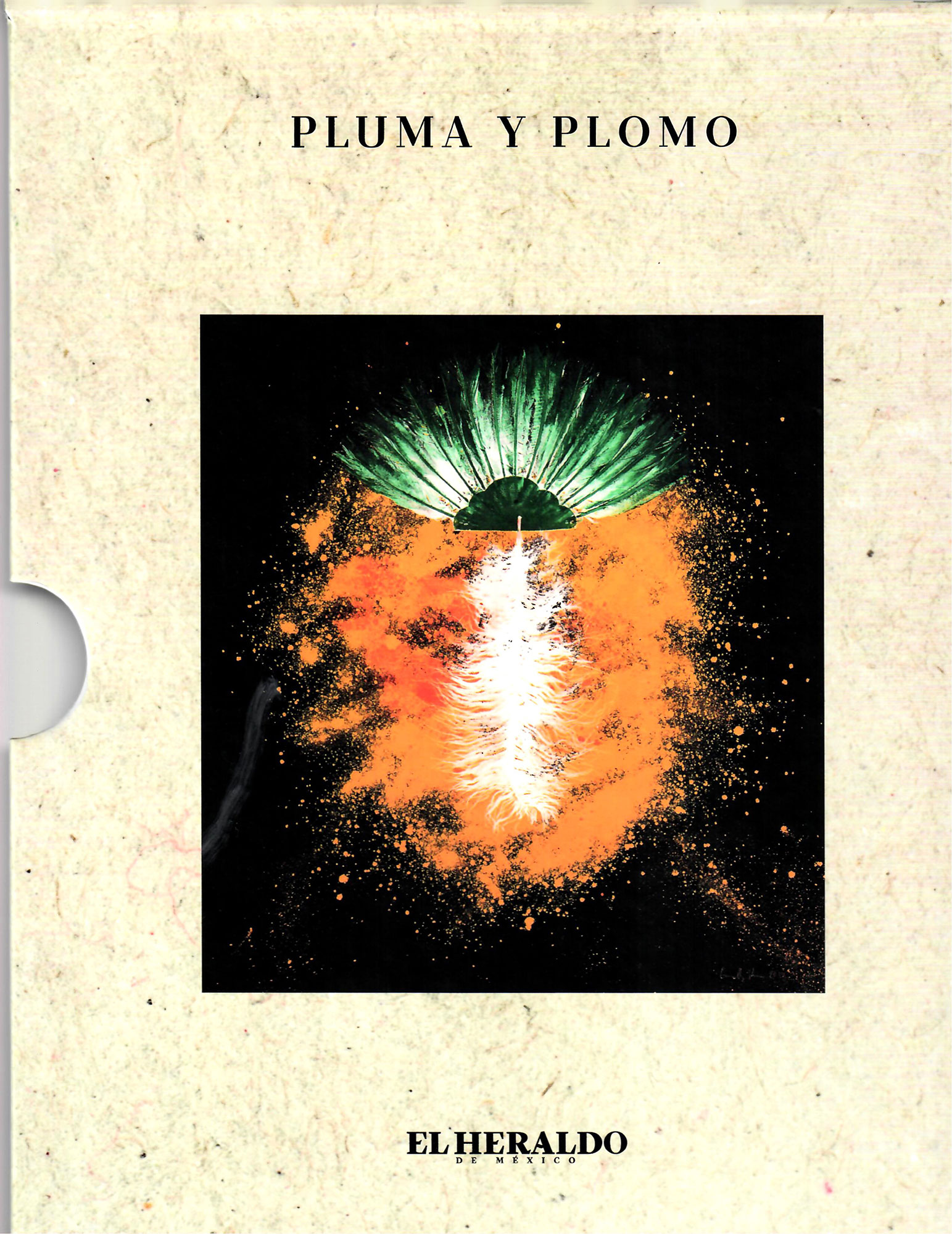
500 años el encuentro Moctezuma y Cortés
Luis Barjau and Christian Duverger
Illustrations by Emiliano Gironella Parra
Heraldo Media Group
Mexico City
Pluma y plomo – Plomo y pluma
Pluma y plomo – Plomo y Pluma (2 volumes), texts by Luis Barjau and Christian Duverger and illustrations by Emiliano Gironella Parra. Heraldo Media Group, Mexico, November 2019.
The feather and lead book project was born from the enthusiasm of a group of intellectuals who at the beginning of the year set the goal for themselves to highlighting the most important event of 2019: the 500th anniversary of the meeting between Emperor Moctezuma and Captain General Hernán Cortés, the beginning of the conquest of Tenochtitlan. “For this reason, throughout this year,” says Angel Mieres Zimmermann in his presentation, “Luis Barjau and Christian Duverger dragged their expertly trained pens across the pages of El Heraldo de México to recount the previous details of that historic meeting in a weekly column”…, Barjau from the perspective of Moctezuma, and Duverger from Cortés´ point of view. Eventually the essays were compiled under two titles: “Moctezuma. The Tragic” and “Cortés. From Santo Domingo to Mexico Tenochtitlan”. The double publication is designed express the parallel nature of two distinct visions: that of the emperor and that of the conqueror.
A prologue by Diego Prieto Hernández, “Mexico-Tenochtitlan: 500 years. Alliances, confrontation and conquest”, introduces the essays. 50 works by Gironella Parra (48 monotypes and two paintings made with mixed media on canvas) recreate and illustrate some of the passages described and analyzed in the texts.

Cortés, Escritor
Christian Duverger (compiler)
Illustrated by Emiliano Gironella Parra
Museo Iconográfico del Quijote
Centro de Estudios Cervantinos, A.C.
Fundación Cervantina de México, A.C.
Cortés, escritor
This book is an anthology of papers that revolve around the figure of Cortés the writer, presented within the framework of the International Cervantino Colloquium, whose last three editions (2017, 2018 and 2019) have been dedicated to the study of early Mexican literature, specifically investigating its mestizo dimension. The concept of “literature”, here, includes the stories of the conquest, ethnographic chronicles, the transcriptions of pictographic manuscripts in Latin characters… In this abundant literature, the writings of Hernán Cortés stand out: they are equally important as his exploits of conquest.
Nine texts make up the book, which is divided into two parts: the first brings together five works on the Cartas de Relacion by Cortés officially addressed to the King of Spain, which were always intended for printing and saw various editions; the second includes the studies of four professors who explore the inherent duality of this narrative form, which, in Duverger’s words, “pretends to express submission to royal power, but in reality obeys a great freedom of spirit.”
Cortés, escritor enjoys a great distinction: it is illustrated by Emiliano Gironella, who has already used his artistic talent to defend the cause of Mexico´s reconciliation with its past. In the series of 13 illustrations, 8 made expressly for this collaboration, the feather is a constant element. As a symbol of the wars between indigenous people and a symbol of Hispanic culture, the feather synthesizes the dual life of the conqueror-writer, who straddles the two worlds.
Exhibition catalog
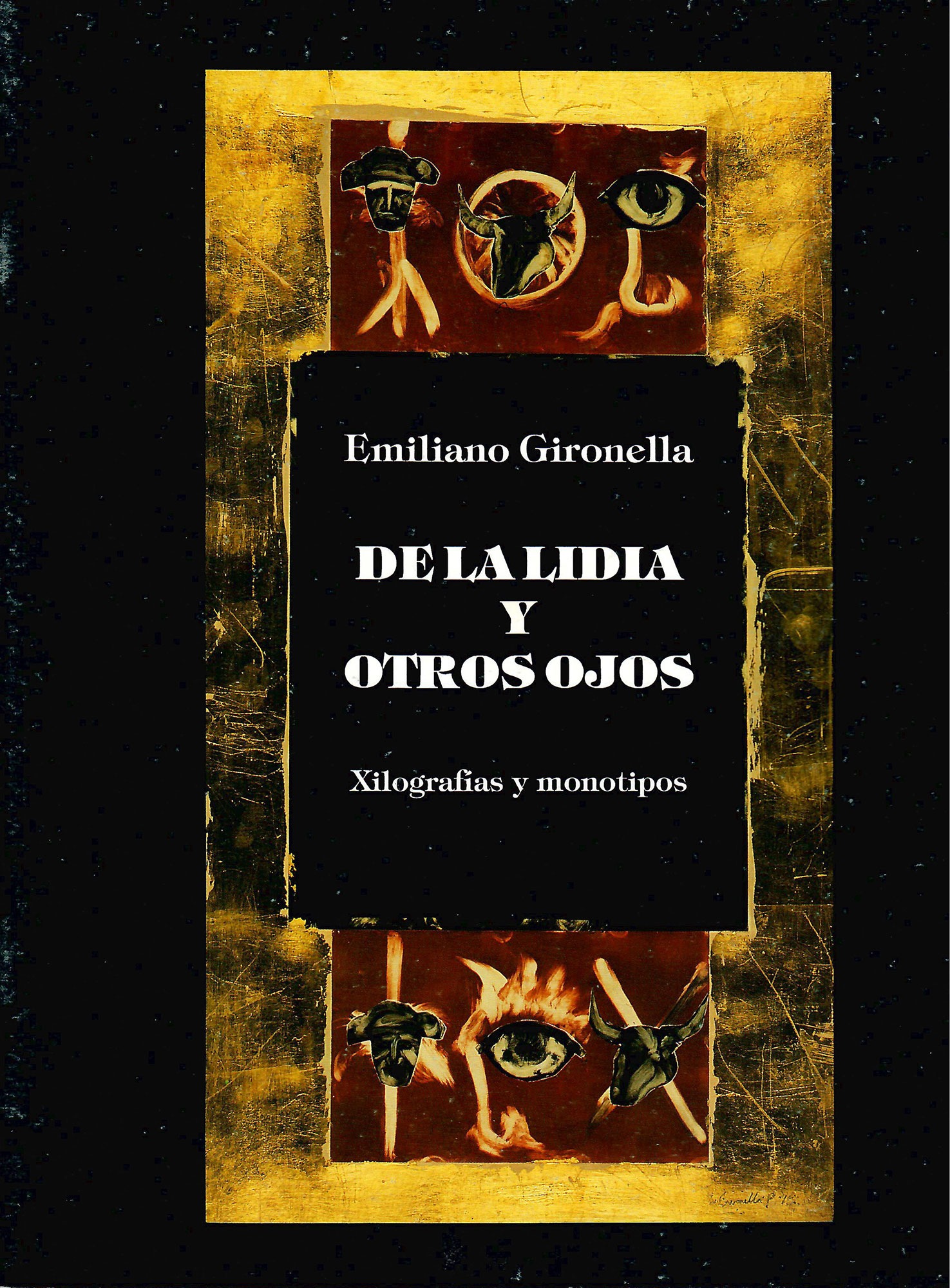
De la lidia y otros ojos
Exhibition by Emiliano Gironella Parra
Consejo para la Cultura y las Artes
Instituto Nacional de Bellas Artes
Mexico City
De la lidia y otros ojos
Two notes introduce the Gironella exhibition: in the first, Beatriz Vidal de Alba, director of the CENART Arts Library, describes the techniques used in the works that make up this exhibition: xylography and monotype, evidence of how Gironella , in his constant search of what to make with his hands, finds the ideal means to express and transmit his treatment of the universe that surrounds him.
In the second, De la lidia y otros ojos, a paraphrase of the title of the Gironella exhibition, Francisco Ahumada Vasconcelos talks about the privilege of artists: creating worlds or discovering them, and the task of the willing spectator: making this experience their own, and discovering new worlds through the world that the creator presents. Eyes that look and let themselves be seen; the dramatic presence of bullfighting as a miracle or revelation; fantastic or unreal faces; faceless eyes that see and do not see, pointing to labyrinths in the works of this exhibition that recognize meaning and secrets, which in many cases are produced without the artists consent.
De la lidia y otros ojos was presented at the Museo Nacional de la Estampa, Mexico City, in 1995. The exhibition consists of 32 works, made with woodcut and monotype printing techniques.
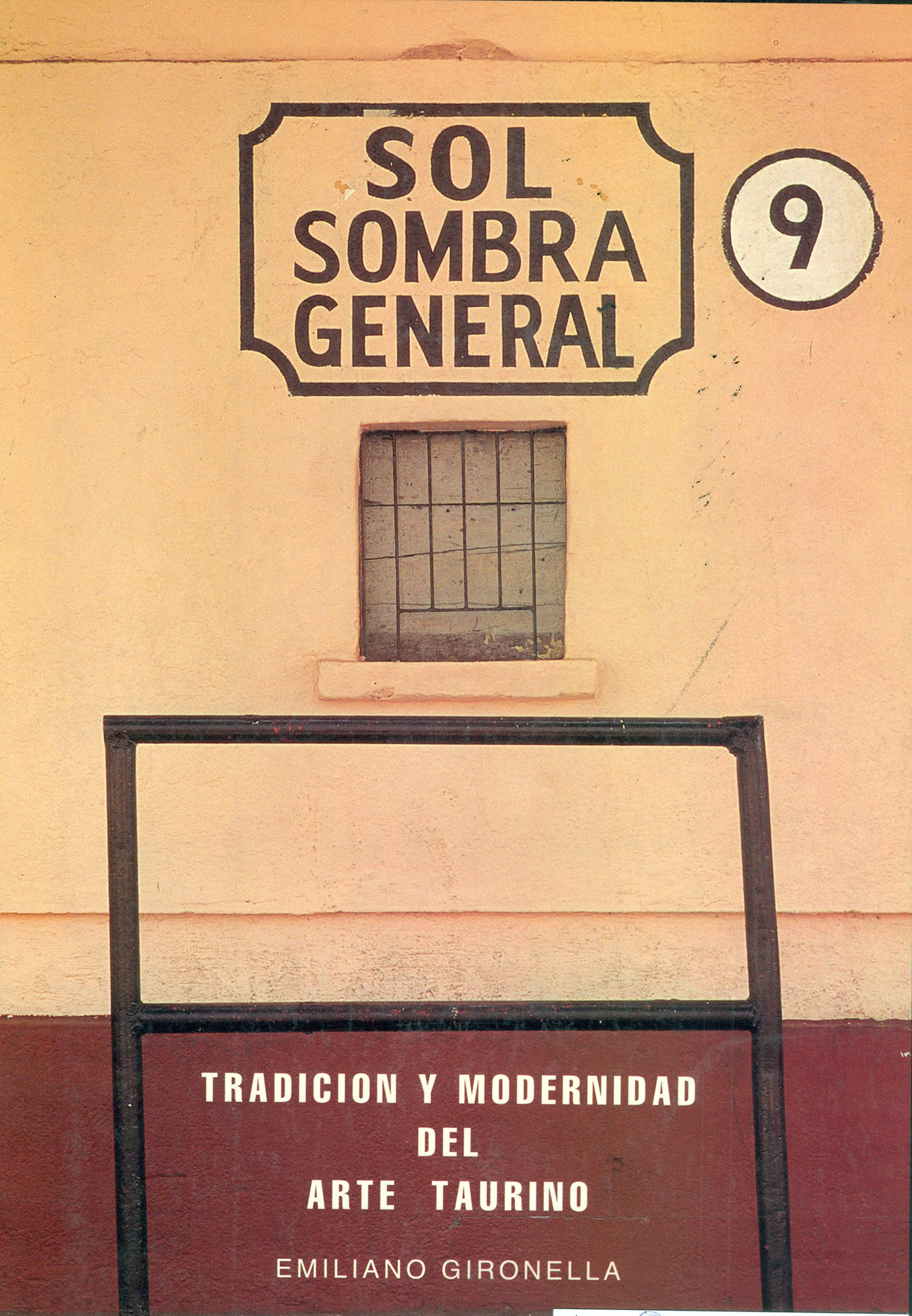
Sol y sombra: tradición y modernidad del arte taurino
Exhibition by Emiliano Gironella Parra celebrating 50 years of Plaza México.
Introduction by Ali Chumacero.
Secretaría de Hacienda y Crédito Público
Mexico City
Sol y sombra: tradición y modernidad del arte tauino
When speaking about the Sol y sombre exhibition, Alí Chumacero establishes similarities between the arts of painting and bullfighting: color and movement, light and shadow, movements of the hand arranging distances, spaces, and relationships to create the environment and circumstance that triggers emotion.
Constant in his love of bullfighting, Emiliano Gironella Parra manages to express in this work, and transmit to those who observe it, his deepest impressions while observing the corrida. The risk and uncertainty, courage and intrepidity, but also the beauty of the passes, the right turns, the classic lines forged by two bodies facing death: one with his animal bravery, the other with his human bravery.
Forty-one works make up the Sol y sombras exhibition, presented at the Museum of the Ministry of Finance and Public Credit in 1997, Mexico City. Emiliano Gironella used different techniques and materials: monotype, encaustic, mixed, gouache, tempera and oil on paper and canvas; tempera and 22-carat gold on wood, as well as bronze in some reliefs and sculptures.
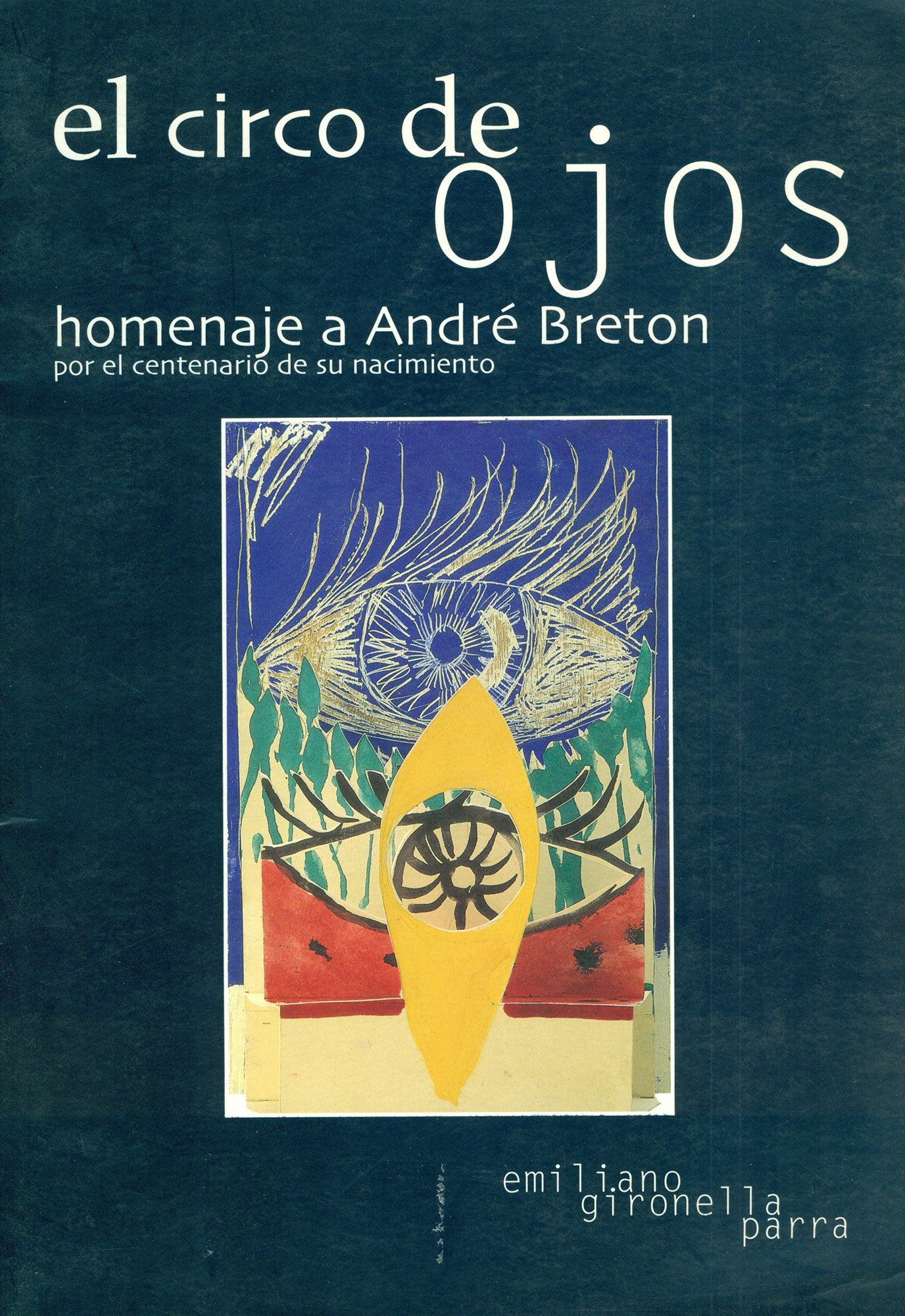
El circo de los ojos
Exhibition by Emiliano Gironella Parra
Tribute to André Bretón on the centennial of his birth
Centro Cultural Casa Lamm
Mexico City
El circo de los ojos
Six works made with gouache, monotype, xylography and mixed media, as well as a red cedar box containing several monotypes, three bronzes and an “object”, make up El circo de los ojos, an exhibition by which Gironella pays tribute to André Breton, the French writer, poet and essayist considered the founder of Surrealism. A phrase or a fragment by Breton, LHV Jakov, Shakespeare, Otto Pächt, Luis Cardoza and Aragón, and one by Gironella himself, precede 8 of the 10 works, texts that may serve as a presentation, or perhaps inspired the artist in his creations. El circo de los ojos, because they appear in Breton’s inkwell; on the four extremes of the cross as the sufferings of Jesus Christ and at his feet; in the center of the bronze flowers, in the red cedar box: all eyes open, almost bare we could say.
El circo de los ojos was presented at the Casa Lamm Cultural Center, Mexico City, in 1996.

Ramón
Exhibition by Emiliano Gironella Parra
Círculo del Arte
Consejo Nacional para la Cultura y las Artes
Madrid, Spain
Ramón sobre las greguerías
Ramón sobre las greguerías. There are, have been and will be many ´Ramon´s in the world, but this name linked to the greguería can only refer to Ramón Gómez de la Serna, the great innovator of 20th century Spanish literature who invented the “greguería”, a literary artifice that mixes humor and metaphor. For this exhibition, Gironella selected a series of greguerias and, under their powerful impact, ingeniously incorporated Ramonian images into his work. In addition to these “illustrative” works, there are two others: one based on the description of the Pombo café, which reveals the unique atmospheres of the tertulias, and another, a portrait, made from the revindication Gómez de la Serna makes of his own Name: Ramon.
Ramón’s literary images and Emiliano’s plastic representations share the same freshness, lucidity and ingenuity.
Ramón sobre las greguerías was inaugurated at the Círculo de Lectores Cultural Center, Madrid, Spain, in 1997. The exhibition consisted of 18 works: oil paintings on canvas, linen, and paper, painted woodcuts, a painted and engraved guitar, as well as another wood carving. Some of these works incorporate glass eyes, another features a bird’s wing and yet another a violin bow.
Along with the work of Emiliano Gironella Parra, the second and fourth volumes of the Complete Works of Ramón Gómez de la Serna were presented, a project consisting of 21 volumes.
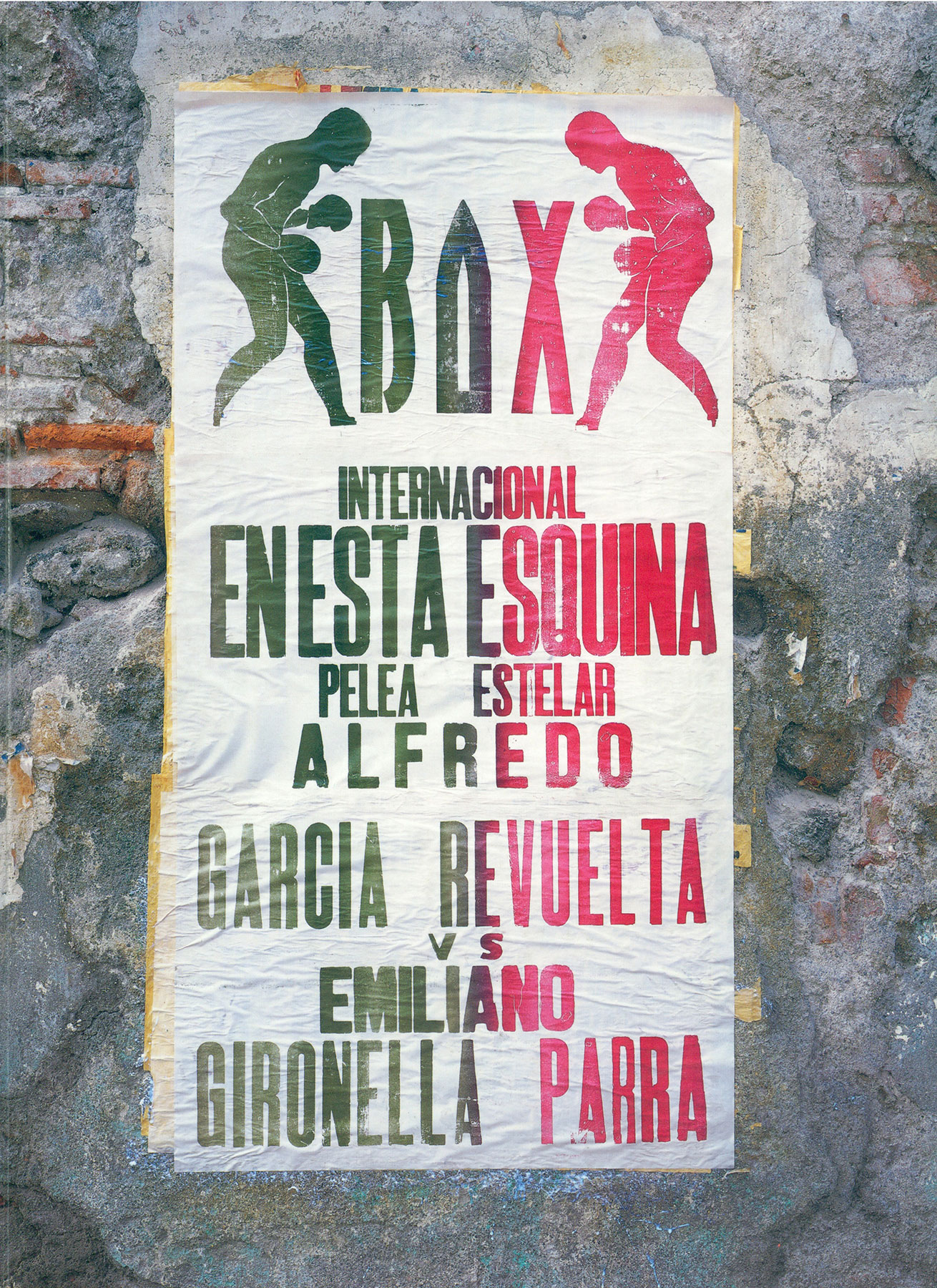
En esta esquina
En esta esquina
Exhibition by Emiliano Gironella Parra and Alfredo García Revuelta
Mexico City
En esta esquina
They defend the sport against those who do not consider it such, declaring boxing an art which has inspired the work of all types of artists. Including, of course, Emiliano Gironella Parra.The following excerpts are representative of the authors´recognition and admiration for Emiliano´s work in this exhibition.
EDUARDO LAMAZÓN: “Emiliano Gironella Parra is not scared by the relentless blow of the red gloves when they reach their destination, shaking the occasional opponent. It inspires him to paint. He knows that an invincible boxer is, at some point, every man, because he embodies a dark universal desire.
”He says that the challenge of adding color to real life is perennially seductive… he has gathered enough material here to create a narrative about boxing that has the entity of a finished work.”
ARTURO RIPSTEIN: “The work of Gironella that accompanies this catalog is not the mere description of moments. The truth in art is not the reproduction, it is the construction… Gironella succeeds.”
En esta esquina, an exhibition that brings together 36 works by Emiliano Gironella Parra and 36 by Alfredo García Revuelta, was exhibited at the Centro Cultural de Arte Contemporáneo, Mexico City, in 2000. Emiliano’s work is made up of monotypes, encaustics, prints, oils on wood, mosaic, oil and wood carving, some paintings made with mixed media, bronzes on wood bases and wood carvings. The work of García Revuelta includes paintings made with beads, sequins, oils on canvas, acrylics on paper, embroidery and polychrome wood.
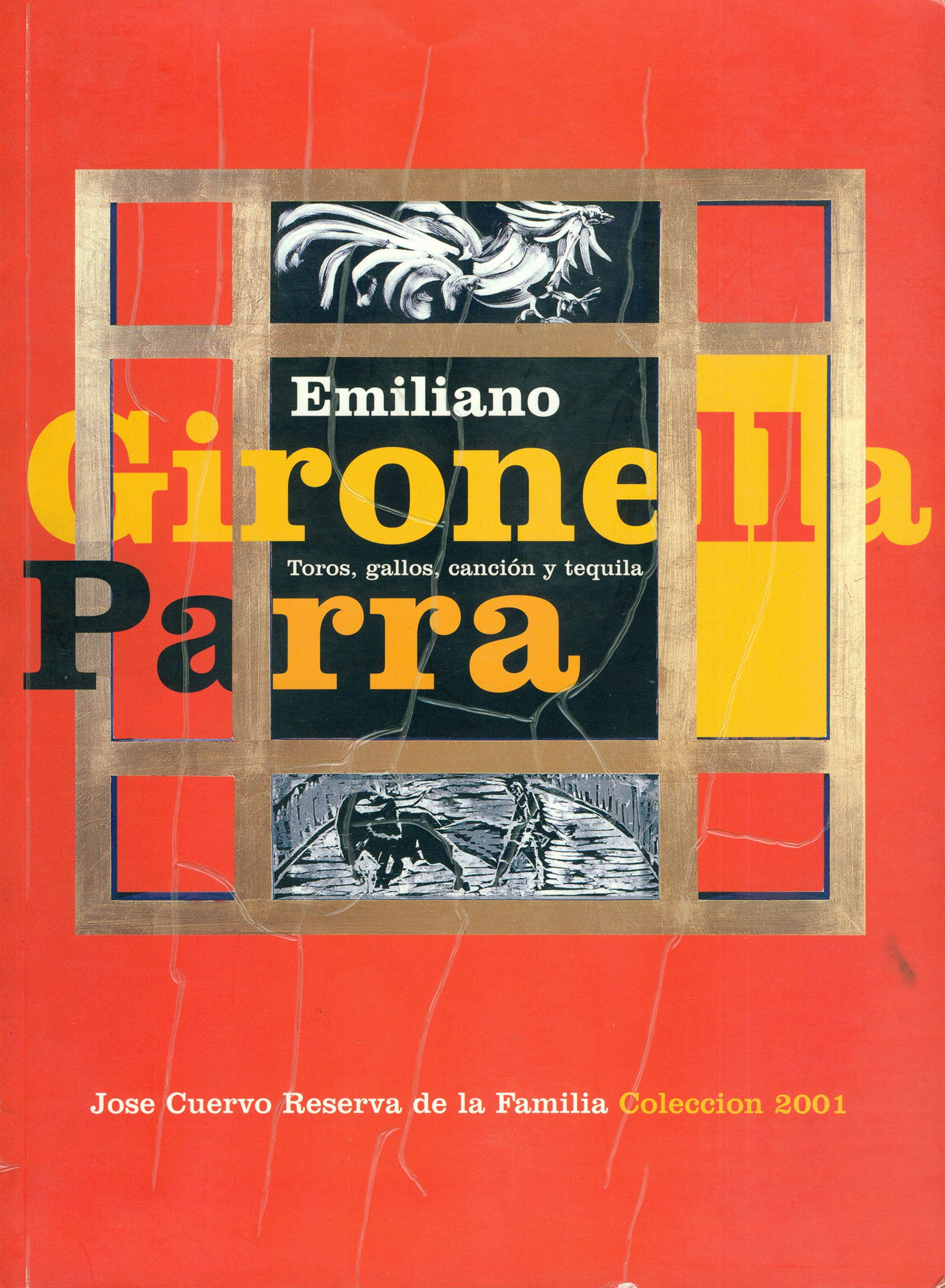
Toros, gallos, canción y tequila
Exhibition by Emiliano Gironella
Hacienda la Riojeña
Tequila Jalisco
Toros, gallos, canción y tequila
Emliano Gironella Parra has always dedicated part of his artistic work to highlighting popular customs and traditions, recreating with talent and ingenuity the atmospheres that give them life. In this exhibition he adds roosters and tequila to the bulls and the song previously addressed in his work. in a tour of the exhibition catalog, an eye that is not expert but rather that of a spectator could notice the red color of the bullfighter’s cape and the blood that flows from the animal’s back and associate it with the bravery of both; in the ruffled feathers and agitated air as evidence of a duel to the death between roosters; in the hands of the mariachis busy plucking the strings of their instruments, their mouths open- tunnel like- making it clear that they sing at the top of their lungs to accompany the festive music, in an atmosphere where surely those gathered toast each other with the national drink: tequila.

Al alimón cantinero
Exhibition by Emiliano Gironella Parra y Demián Flores
Anthology of literary texts dedicated to the cantina compiled and selected by Miguel Flores Ramírez
Mexico City
Al alimón cantinero
In the presentation of Al alimón cantinero included in the catalogue, Antonio Calera-Grobet mentions that for Emiliano Gironella Parra and Demián Flores Cortés, the idea of undertaking a project together arose from a collaborative engraving they made years ago of an idyllic scene in a Mexican cantina. The series presented in Al alimón cantinero is the result of several work sessions, during which the authors assimilated “the rhythm of someone else’s doll”, allowing themselves to be “accompanied by another form of composition, another way of understanding plastic work”. The joint work meant “a process of assimilation of playful and productive otherness, a way of filtering into an unknown habitat to achieve a third party… There was no other intention here other than the recording of what was experienced, to provoke a game of harmony.” And perhaps there —proposes Calera-Grobet— lies its merit: in its relaxed and parallel horizontal intentions, traveling in the opposite direction of the solemnized world”.
Phrases by well-known poets, narrators and essayists, or fragments of popular songs accompany the printed works in the first part of the exhibition catalogue. The second part is made up of the section “Drinks in verse, prose and lines”, an anthology of literary texts dedicated to the cantina compiled and selected by Miguel Flores Ramírez, including “Líneas y desfiguros” by Emiliano and Demián.
Alimón cantinero, an exhibition sponsored by the Casa José Cuervo in support of young Mexican art, was exhibited at the Arcos Itatti Gallery, Mexico City, in 2004. The exhibition consisted of around 50 works co-authored by Emiliano Gironella Parra and Demián Flores Cortés (monotypes, woodcuts, serigraphs, encaustics, oils on canvas, a drypoint drawing), and four by Emiliano (two steel sheets and two labels with serigraphy).
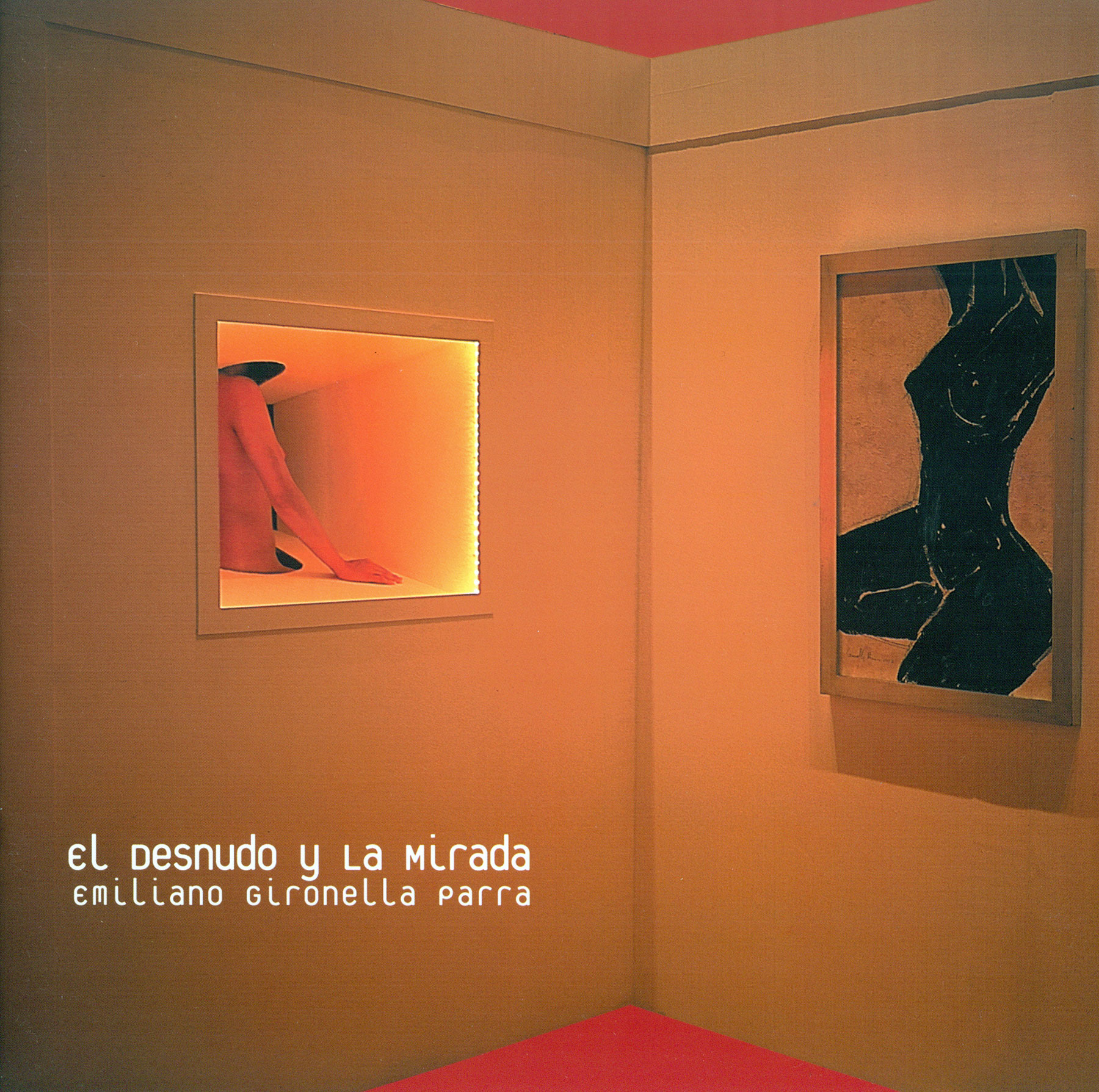
El desnudo y la mirada
Exhibition by Emiliano Gironella Parra
Origina
El Aire Centro de Arte A.C.
Mexico City
El desnudo y la mirada
“Like a yearning for thematic balance, a sort of balancing of genres, Gironella Parra now bursts forth from another voice, whose most intimate tessitura forces us into silence and cont emplation”, says Antonio Calera-Grobet in the opening lines of his presentation to the exhibition El desnudo y la mirada. Far from the dramatization and the sad odes of femininity, Gironella presents in his exhibition an eroticism close to the concept of Octavio Paz, expressed in his essay, “La llama doble”: “sexuality raises the red flame of eroticism and this, at the same time, sustains and raises another flame, blue and tremulous: that of love”. As a metaphor for the love of eroticism, “Gironella Parra’s is a decanted eroticism that has been known to suspend between both extremes due to the success of its artifice”. Thanks to a tone of comforting insinuation, the viewer is invited to create dialogues between the female nudes made by Gironella and the gaze awakened by the nude women in situ that inhabit the showcases, paired museographically in the exhibition.
El desnudo y la mirada was exhibited at the Arcos Itatti Gallery, Mexico City, in 2002. The exhibition comprised works made of monotype, printing, fresco, drawing and printing, ink and acrylic, acrylic on amate paper, encaustic, encaustic and oil on wood, encaustic on wood, as well as a bronze with alebrijes claws, 24 creations in all.

Primero el ojo después la palabra
Exhibition by Emiliano Gironella Parra
Tribute to Sor Juana Inés de la Cruz
Group BMV
Mexico City
Primero el ojo después la palabra
The intersection of poetry, literature and images is a constant in the work of Emiliano Gironella. His themes are rooted in the most diverse manifestations of universal culture and flourish under the mastery of the multiple techniques he handles. In Primero el ojo después la palabra, a tribute to Sor Juana Inés de la Cruz, Gironella plastically interprets some verses of the poem First dream, which the Hieronymite nun affirms “is the only one written for my pleasure and not for precepts and prayers”.
In this exhibition, Gironella expresses in images the meaning that the words set in verse by Sor Juana have for him, words that in turn express the images captured by her through the eyes of her soul. Yes, eyes first, then the word.
Primero el ojo después la palabra was presented in the lobby of Grupo BMV Mexico City in 2011. The exhibition consists of 13 works of different materials: acrylic, texturi, ink, marble dust and gold leaf applied to monotypes, mixed media, drawing and oil techniques on both paper and canvas. In addition, three sculptural castings in methacrylate and one wood and oil carving are part of the exhibition.

México al filo
Exhibition by Emiliano Gironella Parra
Text by Gilberto Prado Galán
El Aire Centro de Arte A.C.
Mexico city
México al filo
“Neither an apology for horror nor a mere symbolization of tragedy,” says Glberto Prado Galán in his introduction “México al filo, morir posterior”, a set of texts that analyze and describe specific acts of decapitation in Mexico as part of the exhibition catalogue. Emiliano Gironella Parra chose as the central theme of his work those killed and beheaded in the war against organized crime. The artist reinterprets these extreme forms of cruelty and violence with his imagination and ironic gesture, moved by “a critical will that reveals the deterioration of a sick society immersed in drug use.” The works that make up this exhibition invite constant reflection on the terrible reality of drug trafficking and drug consumption in Mexico today.
Gironella Parra and Prado Galán combine their talent and creativity in publishing the book-catalogue México al filo. The publication exposes Mexican society to an unbelievable, horrifying reality born within it; a reality that is nurtured and continues to grow under the protective gaze of some, the sideways glance of others, and the blind eyes of more.
México al Filo was exhibited at the Universidad Iberoamericana, Santa Fe campus, Mexico City, in 2011. The exhibition is made up of 28 works made of mixed techniques on wood and canvas, mixed and resin figures, acrylic and oil on canvas, acrylic and wood carving, monotype and marble dust, as well as bronzes with natural hairs, a wood carving and sculptures encapsulated in methacrylate.

¡A San Fermín venimos!
Exhibition by Emiliano Gironella Parra
Introduction by Pepe Malasombra
El Aire Centro de Arte A.C.
Mexico City
¡A San Fermín venimos!
“The most significant actions in life are a party… and when you are part of the party, you make a toast.” With these words, Pepe Malasombra begins his introduction to the exhibition ¡A San Fermín venimos! by Emiliano Gironella Parra. To put it more precisely, in this exhibition, which is not just another bullfighting exhibition, the artist pours out the meaning of significant aspects of the unique bullfighting festival in Pamplona, Spain, which he and his group of friends attended. This exhibition is the sole content of the collaborators of a celebration in distant lands. They are the sum of the experiences of eight days of celebration, enjoyed with a glass of red wine in hand.
The exhibition ¡A San Fermín venimos! by Emiliano Gironella Parra was presented in 2000, at El Aire Centro de Arte Gallery, Mexico City. It consists of fourteen works in various techniques: encaustic on wood carvings, oil on canvas and collage with a variety of materials.
Mentions
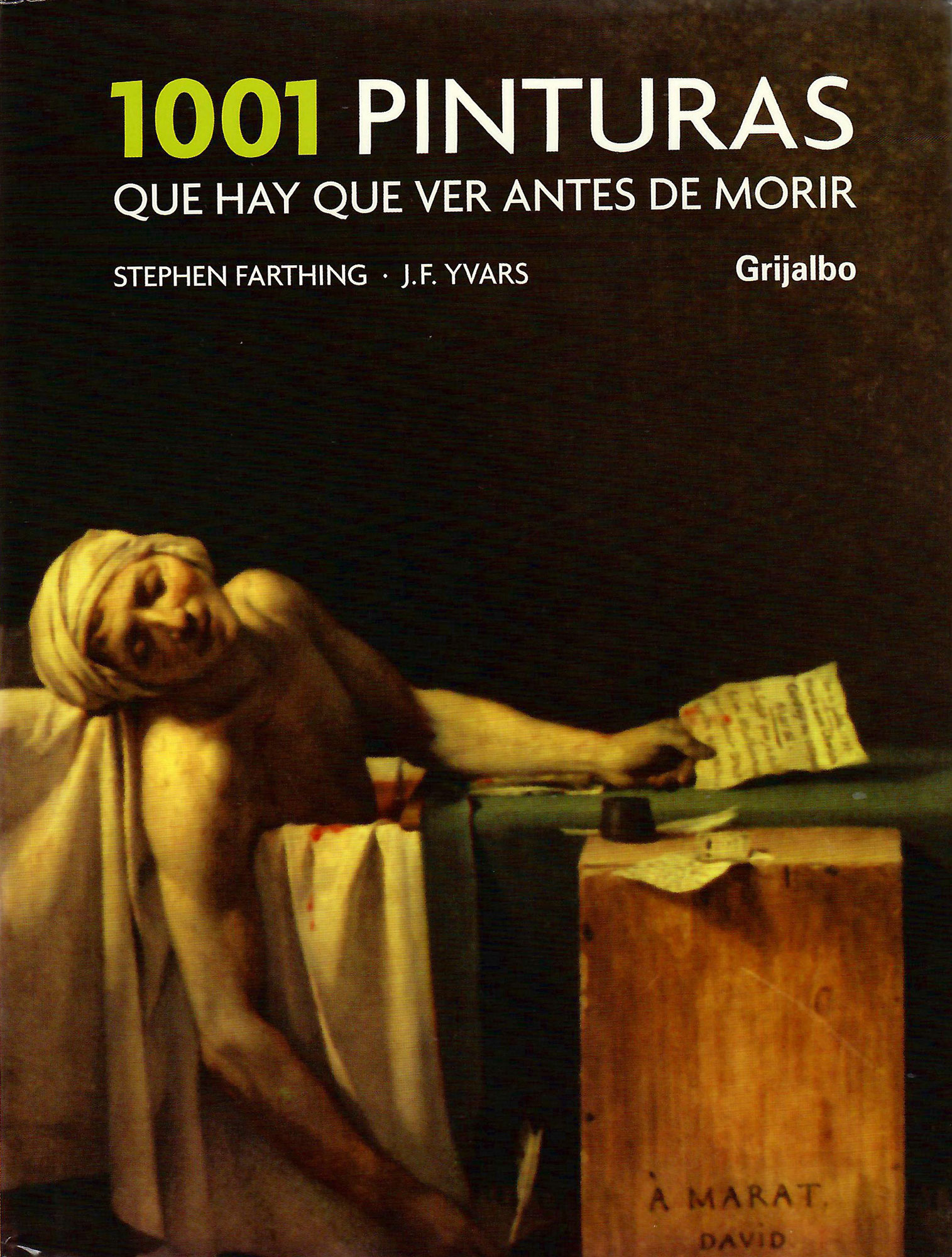
Magazine
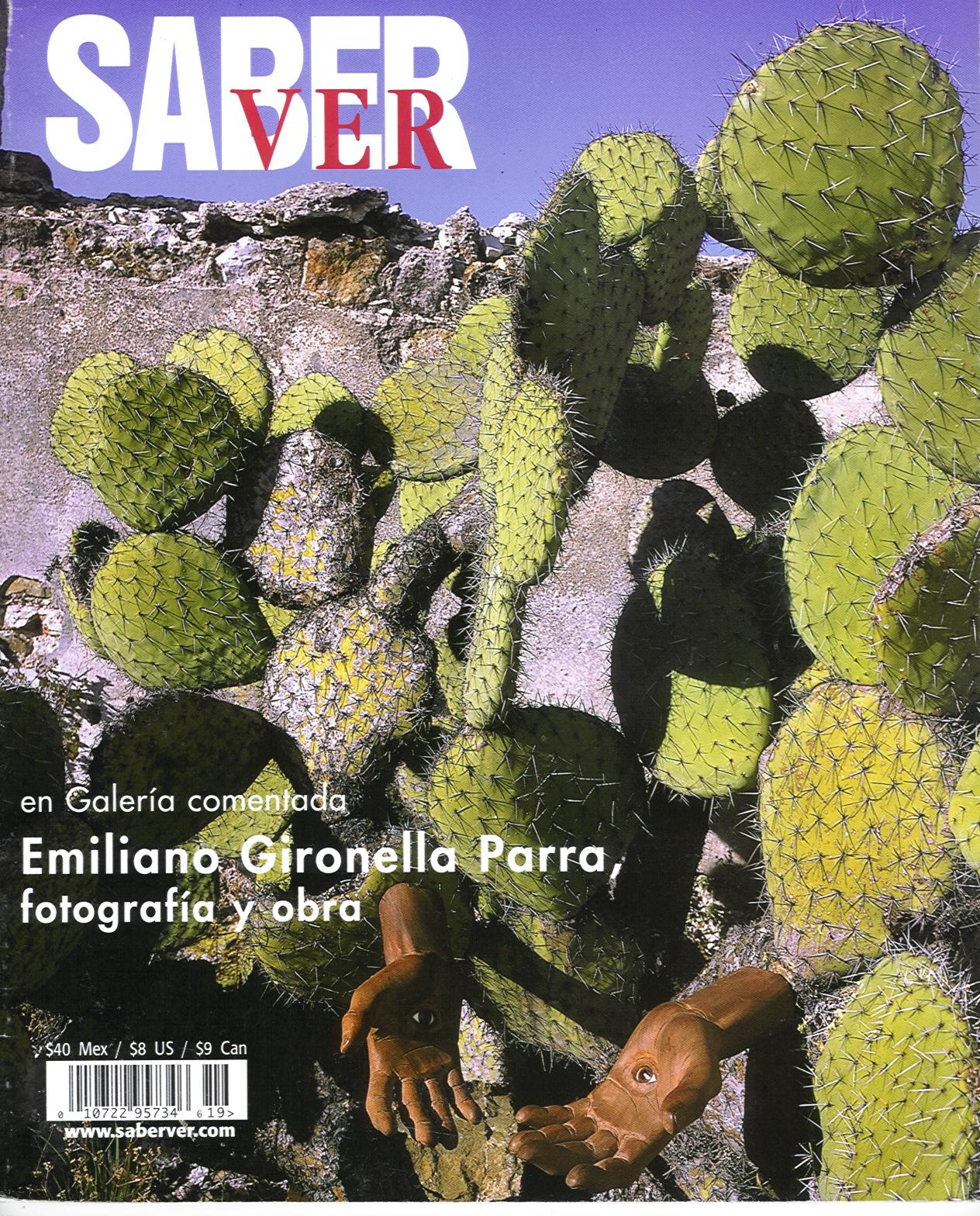
Saber ver
Segunda época número 19 Prensa de Arte Ciudad de México.
